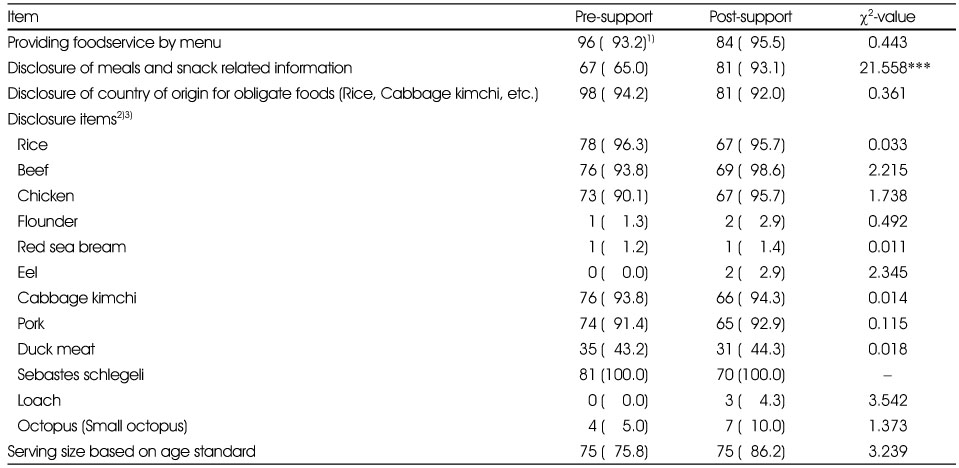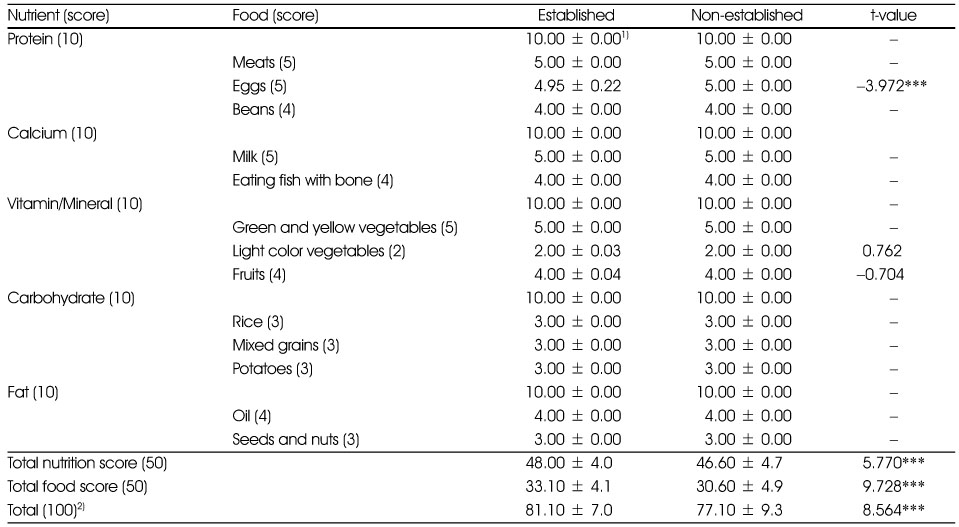References
1. Campbell C, Roe DA, Eickwort K. Qualitative diet indexes: A descriptive or an assessment tool? J Am Diet Assoc 1982;81(6):687–694.
2. Center for Child-care Foodservice Management. 2012. cited 2012 December 30. Available from
http://www.ccfsm.or.kr.
3. Chang H, Ko E. The effectiveness of nutrition education provided by dietitians in child care centers. Korean J Community Nutr 2007;12(3):299–309.
4. Drewnowski A, Renderson SA, Driscoll A, Rolls BJ. The dietary variety score: Assessing diet quality in healthy young and older adults. J Am Diet Assoc 1997;97(3):266–271.
5. Guthrie HA, Scheer JC. Validity of a dietary score for assessing nutrient adequacy. J Am Diet Assoc 1981;78(3):240–245.
6. Hammond GK, Barr SI, McCargar LJ. Teacher's perception and use of an innovative early childhood nutrition education program. J Nutr Educ 1994;26:233–237.
7. Hatloy A, Torheim L, Oshaug A. Food variety: A good indicator of nutritional adequacy of the diet? A case study from an urban area in mali, West Africa. Eur J Clin Nutr 1998;52(12):891–898.
8. Joung HJ, Lee MH, Choi YS, Cho SH. Baseline dietary behaviors of children for nutritional management programs at child care centers in Korea. Korean J Nutr 2000a;33(8):890–900.
9. Joung HJ, Lee MH, Choi YS, Cho SH. Improved nutritional status of children by nutritional management programs at child care centers in Korea. Korean J Nutr 2000b;33(8):901–908.
10. Jung HR, Lee MJ, Kim KC, Kim JB, Kim DH, Kang SH, Park JS, Kwon KI, Kim MH, Park YB. Survey on the sodium contents of nursery school meals in Gyeonggi-do. J Korean Soc Food Sci Nutr 2010;39(4):526–534.
11. Kim AR, Kim MJ, Kim YN. Nutritional assessment of menu plan prepared according to the target pattern-menu prepared by home economics teachers and middle-school girls. Korean J Community Nutr 2011;16(3):375–385.
12. Kim JY, Moon SJ. An ecological analysis of the relationship between diet diversity and nutrient intake. Korean J Nutr 1990;23(5):309–316.
13. Kim SH, Kim JY, Ryu KA, Sohn CM. Evaluation of the dietary diversity and nutrient intakes in obese adults. Korean J Community Nutr 2007;12(5):583–591.
14. Kim SJ. A Study on the relationships between eating habits, personality characteristics and academic performances in the sixth grade of elementary school Kyungnam University; 2000. 1–2.
MS thesis.
15. Kim SY, Yang IS, Yi BS, Back SH, Shin SY, Lee HY, Park MK, Kim YS. Assessment of the foodservice management practices in child care centers and kindergartens. Korean J Food Nutr 2011;24(4):639–648.
16. Kim IS, Yu HH, Kim YS. A study on nutrient intake, food behavior and health conditions according to food intake diversity in the elderly in a local city. Korean J Community Nutr 2001;6(2):205–217.
18. Korea Food & Drug Administration. Center for child-care foodservice management 2012.
19. Korea Food & Drug Administration. Korean childcare service guideline 2013.
20. Krebs-Smith SM, Clark LD. Validation of a nutrient adequacy score for use with women and children. J Am Diet Assoc 1989;89(6):775.
21. Krebs-Smith SM, Smiciklas-Wright H, Guthrie HA, Krebs-Smith J. The effects of variety in food choices on dietary quality. J Am Diet Assoc 1987;87(7):897.
22. Lee BK, Lee JH. Evaluation of dietary variety by body mass index, waist circumference, and exercise habits in female university students. Korean J Food Nutr 2010;23(4):570–581.
23. Lee BS. The survey on the foodservice management system of the child care centers in Ansan. Korean J Food Nutr 2006;19:435–447.
24. Lee GH. An analysis of teachers' awareness of the realities of nutrition education for young children. Early Child Educ Res Rev 2009;13(3):69–96.
25. Lee JE, Ahn Y, Kimm K, Park C. Study on the associations of dietary variety and nutrition intake level by the number of survey days. Korean J Nutr 2004;37(10):908–916.
26. Lee JE, Choi KS, Kwak TK. Assessment of kindergarten principals and teachers' performance degree of foodservice hygiene management and foodservice employees' hygiene knowledge. J Korean Diet Assoc 2012;18(4):308–325.
27. Lee JS, Jeong EJ, Jeong HY. Nutrition survey in the low income area of Pusan: A study on dietary intake and nutritional status. J Korean Soc Food Nutr 1996;25:199–204.
28. Lee JW, Lee MS, Kim JH, Son SM, Yi BS. Nutritional assessment Paju: Kyomunsa. p. 90–92.
29. Lee KH, Park DY, Lee IY, Hong JY, Choi BC, Bae SS. The survey on the nutrition education and food service management system of the early childhood education institute in Yongdungpo. J Korean Diet Assoc 2001;7:167–174.
30. Lee MS, Lee JY, Yoon SH. Assessment of foodservice management performance at child care centers. Korean J Community Nutr 2006;11(2):229–239.
31. Lee Y, Oh YJ. Parents' perception and attitudes to the school meal service program (SMSP) in kindergarten. Korean J Community Nutr 2005;10(2):141–150.
32. Ministry of Education Science and Technology. School foodservice total improvement countermeasure (2007-2011) 2007. p. 5–7.
33. Ministry of Gender Equality. Financial accounting rule of nurture facility 2006. p. 37.
34. Ministry of Health and Welfare. Korean Childcare Accreditation 2010 2010. p. 185–217.
37. Ministry of Health and Welfare. Korean childcare service guideline 2012; childcare foodservice management checklist 2012b.
38. Ministry of Health and Welfare. Child-care facilities foodservice management checklist 2012; Childcare foodservice management checklist 2012c.
39. Ohm JA, Lee SH. A study of the relationship between early childhood teachers attitudes toward early childhood nutrition and their knowledge of nutrition. Korean J Early Child Educ 2004;24(3):5–21.
40. Park HS, Ahn SH. Eating habits and social behavior in Korean preschool children. Korean J Nutr 2003;36(3):298–305.
41. Pyo GS, Lee JY. The improvement and status of child care services in Korea. Korea J Child Care Educ 2002;31:383–420.
42. Rho JO, Lee EP, Lee JS. Assessment of food service management practices in child care centers operated by various types of foundations in the Chonbuk area of Korea. Korean J Food Cookery Sci 2009;25:74–83.
43. Sin EK, Lee YK. Evaluation of food and nutrient intake of preschool children in day-care centers. J Korean Soc Food Sci Nutr 2005;34(7):1008–1017.
44. Sin EK, Lee YK. Development and application of a health belief model based nutrition education program for day care center children. Korean J Community Nutr 2006;11(4):488–501.
45. Sohn CY, Park HO. A Survey on the foodservice management practices at child care centers in Gyeonggi area. J East Asian Soc Diet Life 2011;21(4):577–586.
46. Song YJ, Paik HY. Seasonal variation of dietary intake and quality from 24 hour recall survey in adults living in Yeonchon area. J Korean Soc Food Sci Nutr 1998;27:775–784.
47. Song YJ, Paik HY, Lee YS. Qualitative assessment of dietary intake of college students in Seoul area. J Korean Home Econ Assoc 1998;36:201–216.
48. Steyn NP, Nel JH, Nantel G, Kennedy G, Labadarios D. Food variety and dietary diversity scores in children: Are they good indicators of dietary adequacy? Public Health Nutr 2006;9:644–650.
49. The Korean Nutrition Society. Dietary reference intakes for Koreans 2010.
50. Yon MY, Han YH, Hyun TS. Dietary habits, food frequency and dietary attitudes by gender and nutrition knowledge level in upper-grade school children. Korean J Community Nutr 2008;13(3):307–322.
51. Wright DE, Radiclife J. Parents perceptions of influences on food behavior development of children attending day care facilities. J Nutr Educ 1992;24:198–201.








